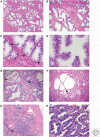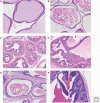Anatomy and Histology of the Human and Murine Prostate
- PMID: 29038334
- PMCID: PMC5932577
- DOI: 10.1101/cshperspect.a030346
Anatomy and Histology of the Human and Murine Prostate
Abstract
The human and murine prostate glands have similar functional roles in the generation of seminal fluid to assist in reproduction. There are significant differences in the anatomy and histology of murine and human prostate and knowledge of the normal anatomy and histology of the murine prostate is essential to interpreting changes in genetically engineered mouse models. In this review, the normal anatomy and histology of both human and mouse prostate will be described.
Copyright © 2018 Cold Spring Harbor Laboratory Press; all rights reserved.
Figures



References
-
- Ittmann M, Huang J, Radaelli E, Martin P, Signoretti S, Sullivan R, Simons BW, Ward JM, Robinson BD, Chu GC, et al. 2013. Animal models of human prostate cancer: The consensus report of the New York meeting of the Mouse Models of Human Cancers Consortium Prostate Pathology Committee. Cancer Res 73: 2718–2736. - PMC - PubMed
-
- Knoblaugh S, True L. 2012. Male reproductive system. In Comparative anatomy histology. A mouse and human atlas (ed. Treuting P, et al.), pp. 295–303. Elsevier, Amsterdam.
-
- Paner G. 2010. Prostate gland and seminal vesicle. In Diagnostic pathology: Genitourinary (ed. Amin M et al.), Section 3, pp. 4–156. Amirysis, Salt Lake City, UT.
Publication types
MeSH terms
LinkOut - more resources
Full Text Sources
Other Literature Sources
